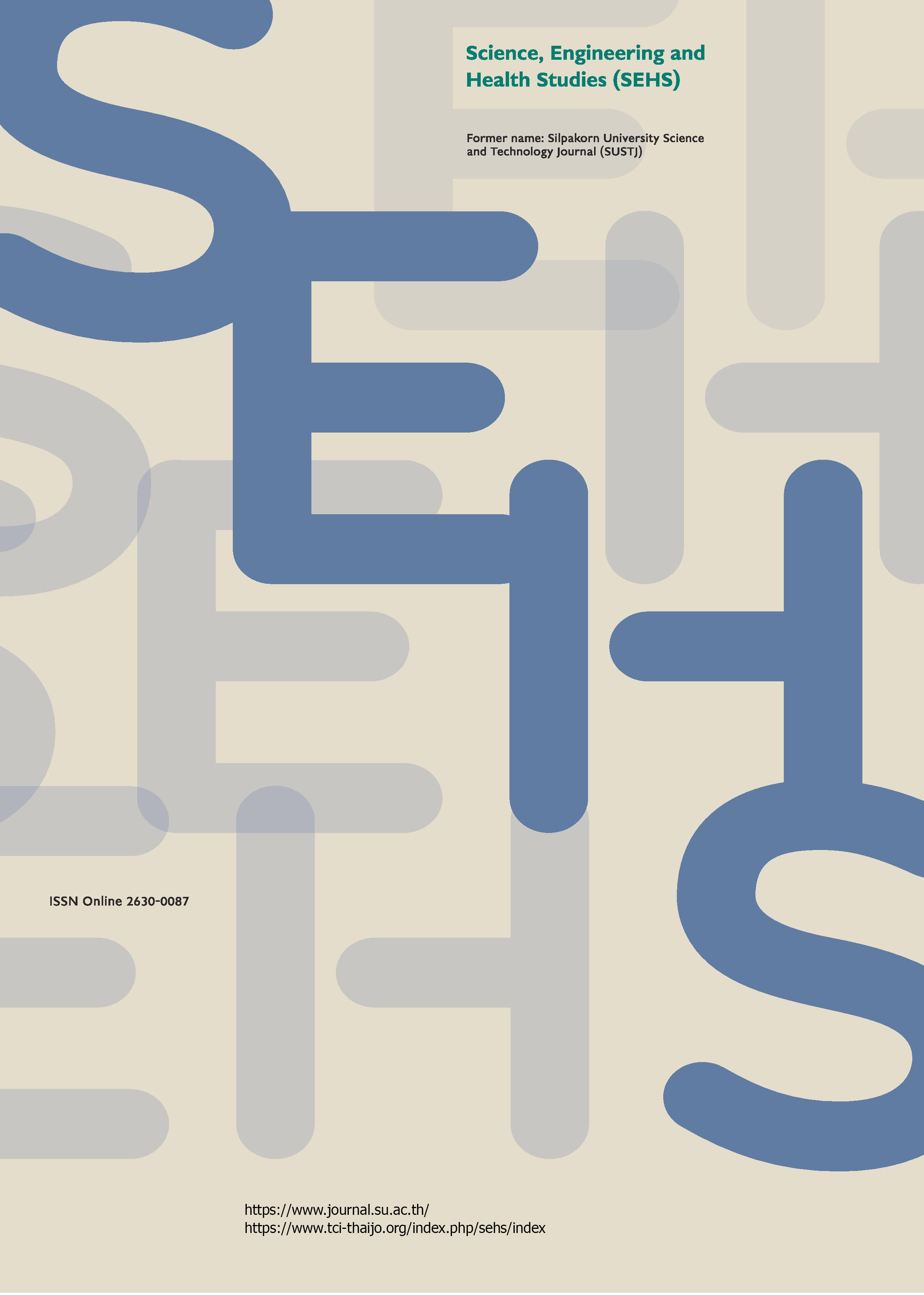Activity of methanolic Andrographis paniculate crude extract and its purified andrographolide against Japanese-encephalitis virus
Main Article Content
Abstract
Infection of Japanese encephalitis virus (JEV) generates brain swelling, namely Japanese encephalitis (JE) in human. This virus is spread by Culex spp. mosquitoes and causes 30% case-fatality rate in Asia and Western Pacific regions annually. No specific cure for the disease is available. Andrographis paniculate methanolic extract and its purified andrographolide exhibit anti-inflammatory and antiviral properties. Our study is focused to antiviral activity of A. paniculate extracts and its elements against JEV in vitro. Half-maximal cytotoxicity (CC50) and the maximum non-toxic doses (MNTD) of A. paniculata in SK-NMC and LLC-MK2 are less than the CC50 and MNTD of andrographolide in SK-NMC and LLC-MK2 at 3 days-post treatment by MTT colorimetric assay. Both A. paniculata and andrographolide have antiviral effect by simultaneous treatment more than pre-treatment and post-treatment at 3 days-post treatment by time-of-addition assay. Antiviral action of these agents interfered virus attachment and had virucidal activity. The results indicated that A. paniculata and andrographolide have the potential antiviral activity against JEV.
Downloads
Article Details

This work is licensed under a Creative Commons Attribution-NonCommercial-NoDerivatives 4.0 International License.
References
Ali-Seyed, M., and Vijayaraghavan, K. (2020). Dengue virus infections and anti-dengue virus activities of Andrographis paniculata. Asian Pacific Journal of Tropical Medicine, 13(2), 49-55.
Aromdee, C., Suebsasana, S., Ekalaksananan, T., Pientong, C., and Thongchai, S. (2011). Stage of action of naturally occurring andrographolides and their semisynthetic analogues against herpes simplex virus type 1 in vitro. Planta Medica, 77(9), 915-921.
Cai, W., Li, Y., Chen, S., Wang, M., Zhang, A., Zhou, H., Chen, H., and Jin, M. (2015). 14-Deoxy-11,12-dehydroandrographolide exerts anti-influenza A virus activity and inhibits replication of H5N1 virus by restraining nuclear export of viral ribonucleoprotein complexes. Antiviral Research, 118, 82-92.
Chen, J. X., Xue, H. J., Ye, W. C., Fang, B. H., Liu, Y. H, Yuan, S. H., Yu, P., and Wang, Y. Q. (2009). Activity of andrographolide and its derivatives against influenza virus in vivo and in vitro. Biological and Pharmaceutical Bulletin, 32(8), 1385-1391.
Lee, J. C, Tseng, C. K, Young, K. C, Sun, H. Y., Wang, S. W., Chen, W. C, Lin, C. K., and Wu, Y. H. (2014). Andrographolide exerts anti-hepatitis C virus activity by up-regulating haeme oxygenase-1 via the p38 MAPK/Nrf2 pathway in human hepatoma cells. British Journal of Pharmacology, 171(1), 237-252.
Lin, T. P., Chen, S. Y., Duh, P. D., Chang, L. K., and Liu, Y. N. (2008). Inhibition of the Epstein-Barr virus lytic cycle by andrographolide. Biological and Pharmaceutical Bulletin, 31(11), 2018-2023.
Luangboribun, T., Tiewcharoen, S., Rabablert, J., Auewarakul, P., Lumlerdkii, N., Junnu, V., and Roytrakul, S. (2014). Screening of anti-amoebic activity on Naegleria fowleri in extracts of Thai medicinal plants. In Proceedings of Joint International Tropical Medicine Meeting 2013, pp. 16-22. Bangkok, Thailand.
Priengprom, T., Ekalaksananan, T., Kongyingyoes, B., Suebsasana, S., Aromdee, C., and Pientong, C. (2015). Synergistic effects of acyclovir and 3, 19-isopropylideneandrographolide on herpes simplex virus wild types and drug-resistant strains. BMC Complementary and Alternative Medicine, 15, 56.
Reddy, V. L. N, Reddy, S. M., Ravikanth, V., Krishnaiah, P., Goud, T. V., Rao, T. P., Ram, T. S., Gonnade, R. G., Bhadbhade, M., and Venkateswarlu, Y. (2005). A new bis-andrographolide ether from Andrographis paniculata nees and evaluation of anti-HIV activity. Natural Product Research, 19(3), 223-230.
Roy, S., Chaurvedi, P., and Chowdhary, A. (2015). Evaluation of antiviral activity of essential oil of Trachyspermum ammi against Japanese encephalitis virus. Pharmacognosy Research, 7(3), 263-267.
Schuh, A. J., Ward, M. J., Brown A. J. L., and Barret, A. D. T. (2014). Dynamics of the emergence and establishment of a newly dominant genotype of Japanese encephalitis virus throughout Asia. Journal of Virology, 88(8), 4522-4532.
Seubsasana, S., Pientong, C., Ekalaksananan, T., Thongchai, S., and Aromdee, C. (2011). A potential andrographolide analogue against the replication of herpes simplex virus type 1 in Vero cells. Medicinal Chemistry, 7(3), 237-244.
Tang, L. I., Ling, A. P., Koh, R. Y., Chye, S. M., and Voon, K. G. (2012). Screening of anti-dengue activity in methanolic extracts of medicinal plants. BMC Complementary and Alternative Medicine, 12(1), 3.
Thakur, A. K., Chatterjee, S. S., and Kumar, V. (2012a). General neuropharmacological screening of standardized extract of Andrographis paniculata in rodents. In Proceedings of Annual Conference of Indian Academy of Neurosciences (IAN) with Annals of Neurosciences, pp. 36-37. Amritsar, India.
Thakur, M., Weng, A., Fuchs, H., Sharma, V., Bhargava, C. S., Chauhan, N. S., Dixit, V. K., and Bhargava, S. (2012b). Rasayana properties of Ayurvedic herbs: are polysaccharides a major contributor. Carbohydrate Polymers, 87(1), 3-15.
Uttekar, M. M., Das, T., Pawar, R. S., Bhandari, B., Menon, V., Nutan, F., Gupta, S. K., and Bhat, S. V. (2012). Anti-HIV activity of semisynthetic derivatives of andrographolide and computational study of HIV-1 gp120 protein binding. European Journal of Medicinal Chemistry, 56, 368-374.
Wang, H., and Liang, G. (2015). Epidemiology of Japanese encephalitis: past, present, and future prospects. Therapeutics and Clinical Risk Management, 11, 435-448.
Wen, L., Xia, N., Chen, X., Li, Y., Hong, Y., Liu, Y. J., Wang, Z. Z., and Liu, Y. J. (2014). Activity of antibacterial, antiviral, anti-inflammatory in compounds andrographolide salt. European Journal of Pharmacology, 740(5), 421-427.
Yoksan, S., Rabablert, J., Chaiyo, K., Rajchakam, S., Tiewcharoen, S., Rabablert, N., Kerdkriangkrai, S., Samngamnim, N., Phurttikul, W., and Luangboribun, T. (2013). Cytokine gene expression in human hepatocytes infected with dengue virus serotype 3 (strain-16562). Health, 5(9), 1516-1525.
Yu, B., Dai, C. Q., Jiang, Z. Y., Li, E. Q., Chen, C., Wu, X. L., Chen, J., Liu, Q., Zhao, C. L., He, J. X., Ju, D. H., and Chen, X. Y. (2014). Andrographolide as an anti-H1N1 drug and the mechanism related to retinoic acid-inducible gene-I-like receptors signaling pathway. Chinese Journal of Integrative Medicine, 20(7), 540-545.

